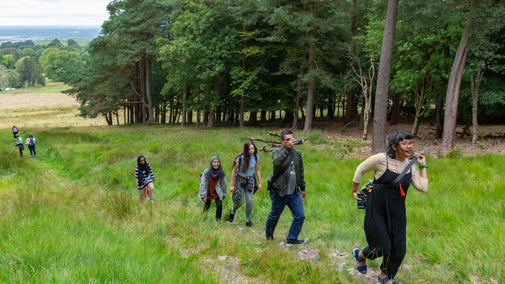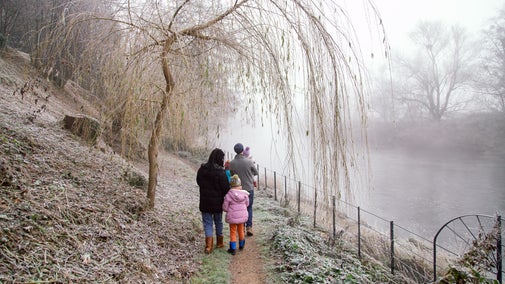Chiltern escarpment and woodland walk
Oxfordshire, Buckinghamshire & Berkshire
This challenging circular trail explores the chalk escarpment of the Chiltern Hills and features sweeping views across the surrounding valleys. It starts at Watlington Hill, where you'll find red kites in the sky and the White Mark carved into the hill side. From here you'll head up and down the valleys navigating the local woodland and farmland, as well as small picturesque villages and hamlets
Near to
Chilterns CountrysideStart point
Watlington Hill car park, Watlington, OX49 5HS. Grid ref: SU709935Trail information
Shorter route available
A shorter route, which is 6.3 miles (10km) and approximately 3 hours long, is available by talking a short-cut between Steps 7 and 13 (See map).
More near here
Watlington Hill and the Wormsley Estate walk
This is a long and fairly challenging walk taking you around Watlington Hill, Pyrton Hill, Cowleaze Wood and the Wormsley Estate.

Exploring the Chiltern Escarpment
This 10 mile walk offers a range of panoramic views across the Chiltern Escarpment and the Aylesbury Vale. See a range of historical and archaeological sites, as well as the pretty village of Ellesborough and the prime minister's country retreat at Chequers.

Watlington Hill circular walk
A 7-mile walk from Watlington Hill that explores chalk grassland and beech woodlands, on the historic landscape of the Chilterns on the border between Buckinghamshire and Oxfordshire.

Watlington Hill short walk
This walk offers memorable views over the Vale of Oxford and Chiltern Escarpment, as well as abundant wildlife and birdlife amongst the site's chalk grassland and woodland habitats.

Get in touch
Chilterns Countryside, c/o Hughenden estate, High Wycombe, Buckinghamshire, HP14 4LA
Our partners

We’ve partnered with Cotswold Outdoor to help everyone make the most of their time outdoors in the places we care for.
You might also be interested in
Walking
Explore some of the finest landscapes in our care on coastal paths, accessible trails, woodland walks and everything in between. Find the best places to walk near you.

Walking in Oxfordshire, Buckinghamshire and Berkshire
From gentle strolls for little legs to longer hikes through the rolling Chiltern hills, these are some of the best walks in Oxfordshire, Buckinghamshire and Berkshire.

Cotswold Outdoor: our exclusive walking partner
Learn about the National Trust’s ongoing partnership with Cotswold Outdoor. Find out how they help us care for precious places and the exclusive discount available for National Trust supporters.

Staying safe at National Trust places
The special places in National Trust care sometimes come with a few risks for visitors, be it coastline or countryside. Find out how to keep safe throughout your visits.

Follow the Countryside Code
Help to look after National Trust places by observing a few simple guidelines during your visit and following the Countryside Code.

Visiting Watlington Hill in the Chilterns Countryside
The wonderful views, rich chalk grassland and downland of Watlington Hill make it a perfect place for walks and wildlife spotting.

Things to see and do in the Chilterns Countryside
Discover the countryside sites of the Chilterns. Find the best viewpoints, walk through ancient woodland or pick a quiet spot to watch for wildlife.

History of the Chilterns Countryside
The countryside of the Chiltern Hills is steeped in history. Explore the past of some of our sites, from royal visits to ancient hillforts.

